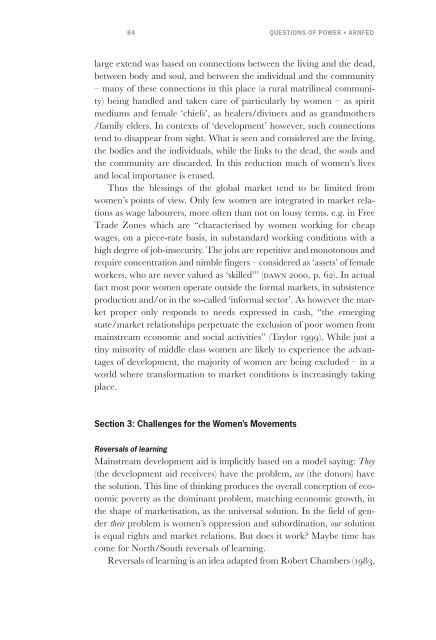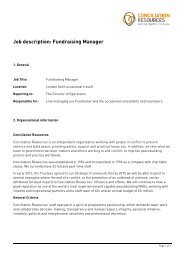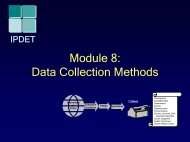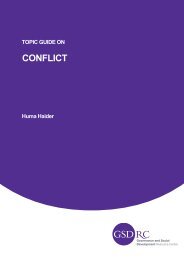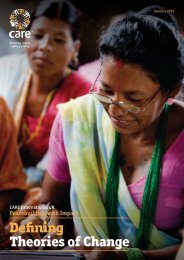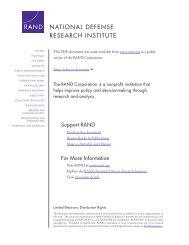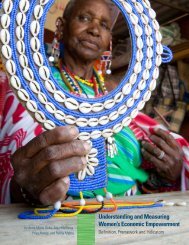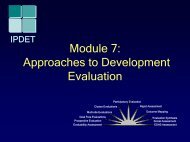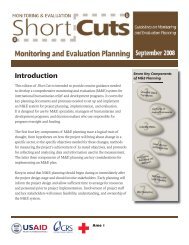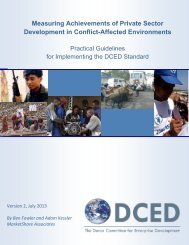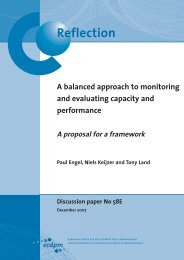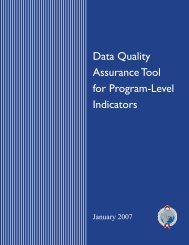Discussing Women's Empowerment - Sida
Discussing Women's Empowerment - Sida
Discussing Women's Empowerment - Sida
Create successful ePaper yourself
Turn your PDF publications into a flip-book with our unique Google optimized e-Paper software.
84<br />
QUESTIONS OF POWER • ARNFED<br />
large extend was based on connections between the living and the dead,<br />
between body and soul, and between the individual and the community<br />
– many of these connections in this place (a rural matrilineal community)<br />
being handled and taken care of particularly by women – as spirit<br />
mediums and female ‘chiefs’, as healers/diviners and as grandmothers<br />
/family elders. In contexts of ‘development’ however, such connections<br />
tend to disappear from sight. What is seen and considered are the living,<br />
the bodies and the individuals, while the links to the dead, the souls and<br />
the community are discarded. In this reduction much of women’s lives<br />
and local importance is erased.<br />
Thus the blessings of the global market tend to be limited from<br />
women’s points of view. Only few women are integrated in market relations<br />
as wage labourers, more often than not on lousy terms. e.g. in Free<br />
Trade Zones which are “characterised by women working for cheap<br />
wages, on a piece-rate basis, in substandard working conditions with a<br />
high degree of job-insecurity. The jobs are repetitive and monotonous and<br />
require concentration and nimble fingers – considered as ‘assets’ of female<br />
workers, who are never valued as ‘skilled’” (DAWN 2000, p. 62). In actual<br />
fact most poor women operate outside the formal markets, in subsistence<br />
production and/or in the so-called ‘informal sector’. As however the market<br />
proper only responds to needs expressed in cash, “the emerging<br />
state/market relationships perpetuate the exclusion of poor women from<br />
mainstream economic and social activities” (Taylor 1999). While just a<br />
tiny minority of middle class women are likely to experience the advantages<br />
of development, the majority of women are being excluded – in a<br />
world where transformation to market conditions is increasingly taking<br />
place.<br />
Section 3: Challenges for the Women’s Movements<br />
Reversals of learning<br />
Mainstream development aid is implicitly based on a model saying: They<br />
(the development aid receivers) have the problem, we (the donors) have<br />
the solution. This line of thinking produces the overall conception of economic<br />
poverty as the dominant problem, matching economic growth, in<br />
the shape of marketisation, as the universal solution. In the field of gender<br />
their problem is women’s oppression and subordination, our solution<br />
is equal rights and market relations. But does it work? Maybe time has<br />
come for North/South reversals of learning.<br />
Reversals of learning is an idea adapted from Robert Chambers (1983,


